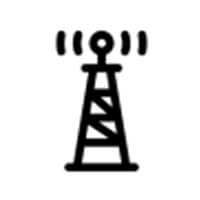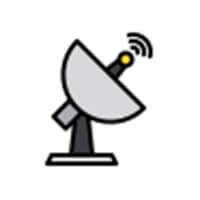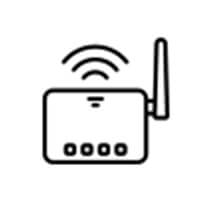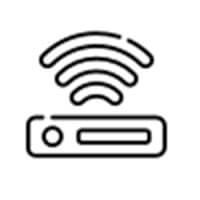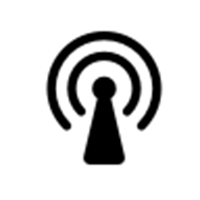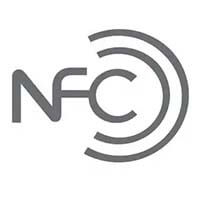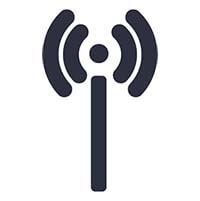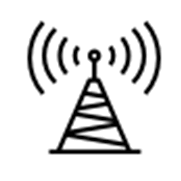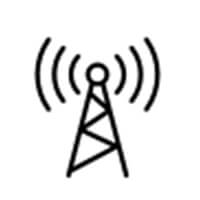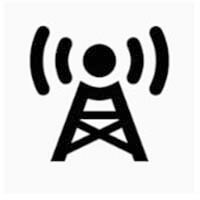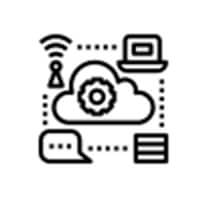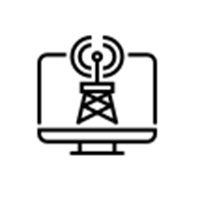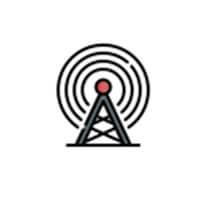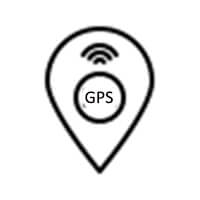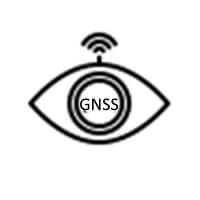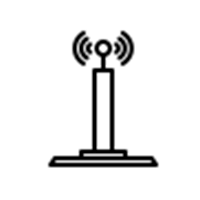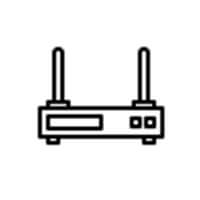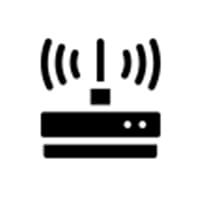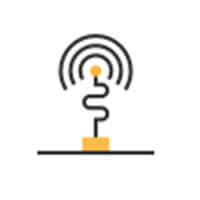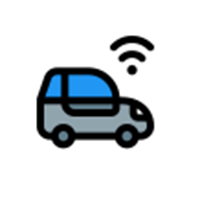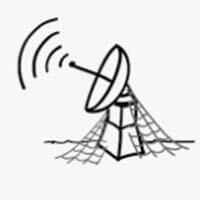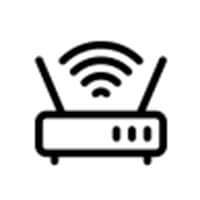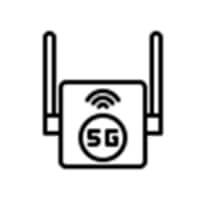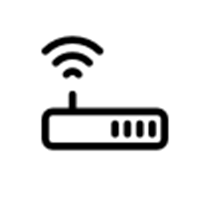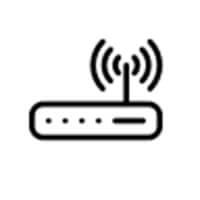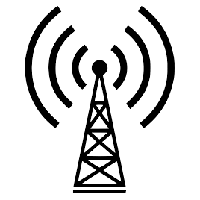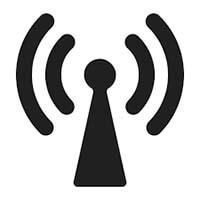Wireless Solutions

Wireless networks (such as wireless bridges and wireless APs) use wireless communication technology to replace traditional network cables or optical fibers to connect two or more different networks. They are suitable for use where wired construction is impossible or inconvenient, such as ports, Construction sites, freight yards, intersections, etc.
It has the advantages of flexible networking, convenient construction, and low cost compared to wired networks. The LSW series bridges work in the 5.8GHz frequency band free of wireless license application, supporting point-to-point, point-to-multipoint, relay, and other modes, which can meet the needs of most application scenarios.
Wireless application refers to various software applications based on the wireless network. It can be large-scale software, such as mobile office, electronic medical treatment, or small software, such as listening to songs, watching movies, and chatting tools.
The wireless solution is a high-speed solution, used to exchange data over short distances and create highly secured personal networks. With Bluetooth capabilities, employees are able to connect phones, laptops, PDAs, and other mobile devices together seamlessly to securely exchange and manage data.
Wireless solutions and applications can be used in business for:
Voice Communications
Wireless Sensing
Item Tracking
Navigation and Location
Quality Management
Risk Management
Networking
Monitoring
Energy Management
Wireless Power Transfer
Paging / Event Notification
We design and manufacture our industrial wireless solutions utilizing the most modern WiFi technology. Our devices are resistant to electromagnetic disturbances, periods of voltage instability, extreme temperature fluctuations, as well as intense shocks and vibrations. Markets such as oil/gas, power/utility, transportation, security, and automation utilize our products for their unmatched reliability and performance. We offer advanced security features suitable for high-speed performance demanding applications.
IoT Solutions In Wireless Solutions
The Internet of Things(IoT) originated in the media field and is the third revolution of the information technology industry.
The Internet of Things(IoT) refers to connecting any object to the network through an information sensing device according to an agreed protocol, and the objects exchange information and communicate through an information transmission medium to achieve intelligent identification, positioning, tracking, supervision, and other functions.
There are two key technologies in IoT applications, namely sensor technology, and embedded technology.
The Internet of Things is an information sensing device such as radio frequency identification (RFID), infrared sensor, a global positioning system(GPS), laser scanner, etc., which connects any item to the Internet according to the agreed protocol, and exchanges and communicates information to achieve intelligence.
A network of identification, location, tracking, monitoring, and management. The concept of the Internet of Things(IoT) was proposed in 1999. The Internet of Things has two meanings.
First, the core and foundation of the Internet of Things(IoT) is still the Internet, which is an extension and expansion of the Internet;
Second, its user terminal extends and expands between any items and information exchange and communication.
Internet of things(IoT) layered
Specifically, the Internet of Things is divided into an application layer, a network layer, and a perception layer. The following are introduced respectively:
- The perception layer is the skin and facial features of the Internet of Things to identify objects and collect information.
The perception layer includes two-dimensional code tags and readers, RFID tags and readers, cameras, GPS, sensors, terminals, sensor networks, etc. It mainly recognizes objects and collects information, similar to the role of skin and facial features in the human body structure.
The perception layer is also called the source layer.
Taking the Internet of Vehicles as an example, the source layer is a base station cluster layer composed of automotive digital standard sources (commonly known as electronic license plates), it is composed of base stations of different types and different functions, which realizes the collection of car-related information and is the transmission layer of car-related information.
- The network layer is the transmission and processing of the neural center and brain information of the Internet of Things(IoT).
The network layer includes a converged network of communications and the Internet, a network management center, an information center, and an intelligent processing center. The network layer transmits and processes the information obtained by the perception layer, similar to the nerve center and brain in the human body structure.
The network layer is divided into a support layer and a data layer. The data layer is composed of multiple databases (including some of the data collected by the existing car-related management platforms of public security, transportation, and other departments).
It is the storage layer of car-related information, and the definition of its data structure is the most critical.
3) The application layer is the Internet of Things to achieve extensive intelligence.
The Internet of Things(IoT) will also have many broad uses, covering smart transportation, environmental protection, government work, public safety, safe home, intelligent fire protection, industrial monitoring, elderly care, personal health, flower cultivation, water system monitoring, food traceability, enemy investigation and Intelligence gathering and other fields.
IoT application technology
This major cultivates mastery of IoT technologies such as radio frequency, embedded, sensors, wireless transmission, information processing, IoT domain names, etc.,
Masters the expertise and skills of key design of the sensing layer, transmission layer, and application layer of the IoT system, RFID system, local area network, security monitoring system, and other engineering design, construction, installation, commissioning, maintenance and other business capabilities, high-end skilled personnel with good service awareness, and professional ethics.
IoT solutions allow companies to easily take advantage of the benefits of IoT as a robust, secure, powerful grid of connected devices, buildings, and infrastructure. With accessible and transparent data from the network’s edge, companies can gain insights into operational efficiencies and new revenue sources.
IIoT Solutions In Wireless Solutions
Industrial Internet of Things(IIoT) is the continuous integration of various types of acquisition and control sensors or controllers with sensing and monitoring capabilities, as well as mobile communications and intelligent analysis into all aspects of the industrial production process, thereby greatly improving manufacturing efficiency, improving product quality, and reducing products.
Cost and resource consumption will eventually realize the promotion of traditional industries to a new stage of intelligence. In terms of the application form, the application of the Industrial Internet of Things(IIoT) has the characteristics of real-time, automation, embedded (software), security, and information interoperability.
The Industrial Internet of Things can be defined as machines, computers, and people using the advanced data analysis results achieved by business transformation to achieve intelligent industrial operations.
In the context of Industry 4.0 or the Industrial Internet, the Industrial Internet of Things(IIoT) has become part of the (IIoT) digital transformation center stage. Data is the key asset and production data in related products and is an indispensable function in the application analysis of globally connected products (in the entire life cycle).
The Industrial Internet of Things (IIoT) is the largest and most important component of the Internet of Things (IoT), although, from the perspective of expenditure, consumer applications are now the largest application area of the Internet of Things (IoT), while industrial Internet of Things (IIoT) applications It mainly started in 2018.
Nevertheless, the Industrial Internet of Things (IIoT) is still becoming more important and advanced in the entire Internet of Things (IoT) application landscape.
Manufacturing is the largest industrial Internet of Things (IIoT) market
The largest application area in the Industrial Internet of Things (IIoT) is manufacturing. It is also the largest industry for IoT spending (including software, hardware, connectivity, and services). The volume of business in the industrial Internet of Things(IIoT) and manufacturing sectors exceeds the total investment of all consumer Internet of Things (IoT) applications in all other industries.
Application of Industrial Internet of Things (IIoT) in logistics and transportation
Transportation is the second-largest market for the Internet of Things (IoT) spending.
Transportation and logistics (T&L) companies actively seek advanced communications and monitoring systems based on the Internet of Things (IoT) to enhance their position in the entire value chain.
The transportation market is huge and will continue to grow rapidly. Just like the Internet of Things (IoT) in the manufacturing market, the main use of transportation is freight monitoring, and the overall Internet of Things (IoT) transportation cost of goods transportation totals 55.9 billion US dollars. This part of the investment will be before 2020 It is still the main driving force of the market.
Technical experts in the industry have defined four pillars for connecting logistics systems: IT security, communication systems, supply chain monitoring systems, and vehicle/transport tracking. In addition to cloud and analysis, the Industrial Internet of Things (IIoT) is the driving force in the field of connected logistics, of which freight monitoring is one of the leading application scenarios.
The application of Industrial Internet of Things (IIoT) in energy and public utilities
A large number of other evolutions and use cases in the oil and gas, smart grid, and energy and utility markets are also major components of the Industrial Internet of Things (IIoT) market.
The Industrial Internet of Things (IIoT) plays an important role in the entire digital transformation process. The digital transformation in many fields includes the realization of the digital supply chain of most components and the value chain of large ecosystems, which obviously also involve retail/consumer-oriented applications aspect.
However, from the perspective of the Industrial Internet of Things (IIoT), the smart grid is the key to the power supply and network transmission/distribution. Other applications include the effectiveness of factories and the maintenance and data-driven opportunities that result from operations and services supported by smart grids and the Internet of Things(IoT).
Application of Industrial Internet of Things (IIoT) in other industries
Maintenance and services supported by the Industrial Internet of Things (IIoT) are two key application areas in almost all industrial Internet of Things industries.
In many other industrial Internet of Things (IIoT) application scenarios such as healthcare (remote health monitoring, equipment maintenance, etc.), aerospace, robotics, coal mines, oil and gas, mining, metallurgy, etc., predictive maintenance, data-supported services, and Remote possibility monitoring, even links from service to control and operation optimization, all depend on the development of the Industrial Internet of Things(IIoT).
An IIoT solution allows you to use the data platform to track any machinery and diagnose the problem much more easily. Predict machine failure before it happens – Real-time data and online monitoring allow you to analyze what’s happening, but even better is an IIoT solution that can do it for you.
What Is IoT?
The Internet of Things (IoT) refers to the use of various information sensors, radio frequency identification technology, global positioning system, infrared sensors, laser scanners, and other devices and technologies.
Collect any object or process that needs to be monitored, connected, and interacted with in real-time, and collect various required information such as sound, light, heat, electricity, mechanics, chemistry, biology, and location.
Through various possible network accesses, the ubiquitous connection of things and things, things and people can be realized, and the intelligent perception, recognition, and management of objects and processes can be realized.
The IoT is an information carrier based on the Internet and traditional telecommunications networks. It allows all ordinary physical objects that can be independently addressed to form an interconnected network.
The IoT refers to the Internet that connects all things. It is an extension and expansion network based on the Internet. It is a huge network formed by combining various information sensing devices with the Internet. Location, the interconnection of people, machines, and things.
The IoT is an important part of the new generation of information technology, and the IT industry is also called: Pan-interconnection, which means that things are connected and everything is connected. Thus, the Internet of Things is the Internet of things connected.
This has two meanings
First, the core and foundation of the IoT is still the Internet, which is an extension and expansion network based on the Internet;
Second, its user end extends and extends to any item and item for information exchange and communication.
Therefore, the definition of the IoT is to use radio frequency identification, infrared sensors, global positioning systems, laser scanners, and other information sensing equipment to connect any item to the Internet according to an agreed protocol for information exchange and communication to achieve the right network of intelligent identification, positioning, tracking, monitoring and management of items.
Characteristics of the IoT
The basic characteristics of the IoT From the perspective of communication objects and processes, the information interaction between things and people and things is the core of the Internet of Things.
The basic characteristics of the Internet of Things can be summarized as overall perception, reliable transmission, and intelligent processing.
Overall perception can use radio frequency identification, QR code, smart sensors, and other perception devices to perceive and acquire various types of information about objects.
Reliable transmission-through the integration of the Internet and wireless networks, real-time and accurate transmission of object information for information exchange and sharing.
Intelligent processing uses various intelligent technologies to analyze and process the data and information that are sensed and transmitted to realize intelligent monitoring and control.
According to the above characteristics of the IoT, combined with the viewpoint of information science, around the flow of information, the functions of the Internet of Things to process information can be summarized.
(1) The function of obtaining information
It mainly refers to the perception and recognition of information. The perception of information refers to the perception and sensitivity to the attribute state of things and their charging methods; the recognition of information refers to the ability to express the state of things felt in a certain way.
(2) The function of transmitting the information
It is mainly the link of information transmission, transmission, reception, etc., and finally the task of transferring the acquired state information and the way of change from one point in time (or space) to another point, which is often referred to as the communication process.
(3) The function of processing information
Refers to the process of information processing. The use of existing information or perceived information to generate new information is actually the process of making decisions.
(4) The function of effect information
Refers to the process by which information is ultimately effective.
There are many manifestations. The more important thing is to keep the object in a pre-designed state by adjusting the state of the object and its transformation method.
Application of the IoT
The application field of the IoT involves all aspects. The application in the field of infrastructures such as industry, agriculture, environment, transportation, logistics, and security has effectively promoted the intelligent development of these areas, making the limited resources more reasonable use and allocation, thereby Improve the efficiency and benefit of the industry.
Applications in the household, medical and health, education, finance and service industries, tourism, and other fields closely related to life have greatly improved in terms of service scope, service methods, and service quality, greatly improving people’s quality of life;
In the field of national defense and military, although it is still in the research and exploration stage, the impact of the application of the Internet of Things cannot be underestimated.
It can range from equipment systems such as satellites, missiles, aircraft, and submarines to individual combat equipment and the Internet of Things. The embedding of technology has effectively improved military intelligence, informatization, and precision, and greatly improved military combat effectiveness. It is the key to future military reforms.
What is M2M?
The full name of M2M is Machine to Machine, which refers to the transfer of data from one terminal to another, which is the dialogue between the machine and the machine. The M2M application system consists of intelligent machines, M2M hardware, communication networks, and middleware.
In a broad sense, M2M can represent the connection and communication between machine-to-robot-to-machine, machine-to-human, and mobile network-to-machine. It covers all technologies and means for establishing communication connections between people, machines, and systems.
In a narrow sense, M2M is the transfer of data from one terminal to another, that is, a machine-to-machine dialogue. At present, when people refer to M2M, it refers to the communication between non-IT machines and other equipment or IT systems through mobile communication networks.
The development of M2M
The M2M application market is growing rapidly worldwide. With the deepening of related technologies including communication equipment and management software, the cost of M2M products decreases, and the M2M business will gradually mature.
At present, applications in the fields of safety monitoring, machinery services, maintenance services, vending machines, public transportation systems, fleet management, industrial process automation, electric machinery, and urban informatization have been realized in the United States and Canada.
M2M applications
M2M technology provides comprehensive solutions integrating data collection, transmission, analysis, and business management for all walks of life, and realizes that business processes and industrial processes tend to be more automated.
The main application areas include transportation (logistics management, positioning, and navigation), electric power (remote meter reading and load monitoring), agriculture (greenhouse monitoring, animal traceability), urban management (elevator monitoring, street light control), and security (urban And corporate security), environmental protection (pollution monitoring, water, and soil testing), corporate (production monitoring and equipment management) and home (elderly and child care, smart security), etc.
M2M application fields include home application fields, industrial applications, retail and payment fields, logistics and transportation industries, and medical industries.
The difference between M2M and IoT
M2M is one of the four supporting technologies of the Internet of Things(IoT).
M2M is the most common application form of the Internet of Things at this stage. M2M mainly emphasizes the single communication between machine and machine, or a machine to human, which is completed in a relatively closed environment.
And it puts more emphasis on the connection between everything and is relatively more open. In addition, in terms of communication technology, M2M is mainly based on wired communication and wireless communication in wide area network communication, which has certain restrictions.
However, the Internet of Things is very different. In the Internet of Things, everything that involves wide-area technologies will work together. At the same time, the IoT module can not only be implanted into the machine but also in the body of animals and plants for information transmission and information perception in the future.
By comparing the situation of the Internet of Things and M2M, it can be seen that M2M is only a part of the Internet of Things and a subset of the Internet of Things. Only when M2M is scaled up, popularized, and intelligently integrated, and communicated with each other through the network, can the Internet of Things be formed. Therefore, M2M is not the Internet of Things, but the ultimate goal of M2M is the Internet of Things.
IoT And M2M technology
The Internet Of Things (IoT) and Machine to Machine (M2M) space represents a paradigm shift in connectivity. There are now more connected devices than mobile phones and the numbers are growing every year. IoT and M2M cover a range of applications with specific frequency allotments and application requirements.
C&T RF Antennas Inc has a full portfolio of M2M and IoT antennas from robust low profile solutions to sophisticated MIMO offerings and embedded products to ensure that we can provide the correct solution for any connected device and installation context.
Our M2M antenna range features a compact, robust, low-profile weatherproof housing that’s perfect for a variety of IoT and M2M applications.
C&T RF Antennas Inc focuses on providing antennas for the IoT and M2M industries for domestic and foreign users. The company’s antenna products are mainly used in consumer electronics and IoT & M2M wireless communications.
C&T RF Antennas Inc’s domain-based architecture combines the functions of car perception, thinking, and action through intelligence to manage complexity and separate issues related to safety, upgradeability, and functional safety.
Scalable and flexible solutions that can realize fast connections between industrial and commercial systems, and can resist hacker attacks, cloning, tampering, and soft errors in harsh environments.
C&T RF Antennas Inc uses smart mobile solutions to securely connect consumers and their technologies with the world around them, contributing to today’s mobile lifestyle.
By simplifying access to products and services, cities can create new standards of sustainability, efficiency, mobility, and economic growth.
Smart houses are designed to achieve safety, comfort, and energy-saving. C&T RF Antennas Inc’s scalable and flexible solutions help maintain home connectivity and convenient communications and infrastructure.
C&T RF Antennas Inc is RF antenna wireless antenna manufacturer in China, we provide RF Antennas with multi-frequency bands such as 169MHz, 230MHz, 315MHz, 433MHz, 868MHz, 915MHz, VHF&UHF, Lora, NB-IoT, ADS-B, GSM, GNSS, Wifi 2.4GHz, 5.8GHz, 2G 3G 4G LTE, GPS, 5G NR, etc.
We provide the indoor-outdoor antenna with many antenna types such as Dipole Antennas, Whip Antennas, Marine Antennas, Router Antennas, MIMO Antennas, PCB Antennas, FPC Antennas, Spring Antennas, Sector Antennas, Yagi Antennas, etc.
Please do not hesitate to contact us for more details.
Wireless Solution Case Studies
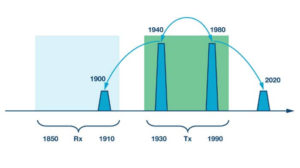
Passive Intermodulation PIM Challenges and Solutions
Today, we talk about the Passive Intermodulation PIM in Base Stations, Passive Intermodulation PIM’s challenges, and solutions. Active devices are known to produce nonlinear effects
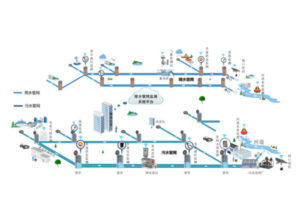
Smart Drainage Network Monitoring System Solution
After the read, you will learn about the Smart drainage network monitoring System Solution Overview, System structure, System functions, System features. System Overview Through the
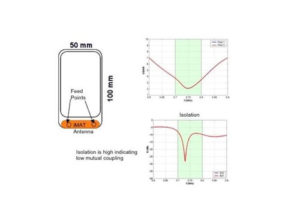
4G Smartphone Antenna Design Solution
Why 4G Smartphone Antenna Design is so impartant? In mobile data devices, the antenna is the only component that touches the network, and optimizing antenna
C&T RF Antennas Manufacturer Product Categories
-
Yagi Antennas (4)
-
Wi-Fi Antennas (180)
-
Whip Antennas (125)
-
UWB Antennas (20)
-
UHF VHF Antennas (34)
-
Sector Antennas (2)
-
Router Antennas (206)
-
PCB Antennas (140)
-
Omnidirectional Antennas (854)
-
NFC Antennas (28)
-
NB-IoT Antennas (57)
-
MIMO Antennas (67)
-
Marine Antennas (257)
-
Magnetic Antennas (44)
-
LoRa Antennas (303)
-
IoT M2M Antennas (874)
-
Internal Antennas (528)
-
GSM Antennas (67)
-
GPS Antennas (71)
-
GNSS Antennas (29)
-
FPC Antennas (209)
-
External Antennas (575)
-
Directional Antennas (17)
-
Dipole Antennas (698)
-
Connectors And Adapters (20)
-
Combo Antennas (74)
-
Coil Antennas (90)
-
Cellular Antennas (180)
-
Car Antennas (160)
-
Cable Assemblies (21)
-
Antenna Accessories (118)
-
Amplifiers And Repeaters (73)
-
ADSB Antennas (4)
-
915MHz Antennas (135)
-
868MHz Antennas (132)
-
5G Antennas (74)
-
4G Antennas (208)
-
433MHz Antennas (105)
-
315MHz Antennas (17)
-
230MHz Antennas (6)
-
169MHz Antennas (9)

